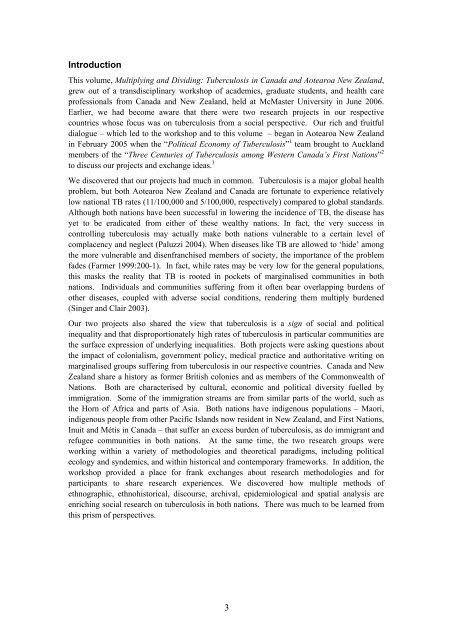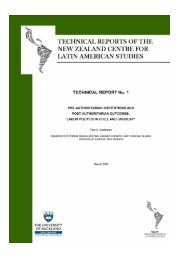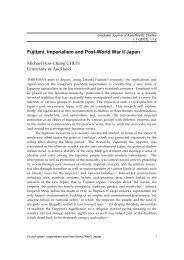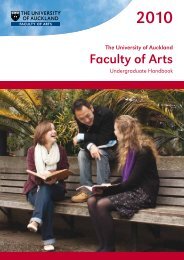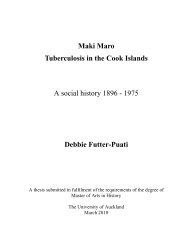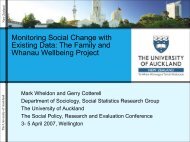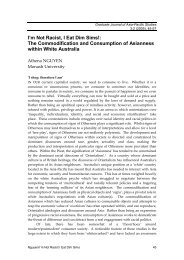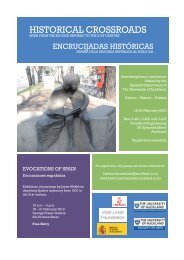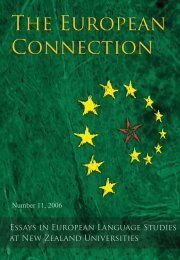Multiplying and Dividing - The University of Auckland
Multiplying and Dividing - The University of Auckland
Multiplying and Dividing - The University of Auckland
Create successful ePaper yourself
Turn your PDF publications into a flip-book with our unique Google optimized e-Paper software.
IntroductionThis volume, <strong>Multiplying</strong> <strong>and</strong> <strong>Dividing</strong>: Tuberculosis in Canada <strong>and</strong> Aotearoa New Zeal<strong>and</strong>,grew out <strong>of</strong> a transdisciplinary workshop <strong>of</strong> academics, graduate students, <strong>and</strong> health carepr<strong>of</strong>essionals from Canada <strong>and</strong> New Zeal<strong>and</strong>, held at McMaster <strong>University</strong> in June 2006.Earlier, we had become aware that there were two research projects in our respectivecountries whose focus was on tuberculosis from a social perspective. Our rich <strong>and</strong> fruitfuldialogue – which led to the workshop <strong>and</strong> to this volume – began in Aotearoa New Zeal<strong>and</strong>in February 2005 when the “Political Economy <strong>of</strong> Tuberculosis” 1 team brought to Auckl<strong>and</strong>members <strong>of</strong> the “Three Centuries <strong>of</strong> Tuberculosis among Western Canada’s First Nations” 2to discuss our projects <strong>and</strong> exchange ideas. 3We discovered that our projects had much in common. Tuberculosis is a major global healthproblem, but both Aotearoa New Zeal<strong>and</strong> <strong>and</strong> Canada are fortunate to experience relativelylow national TB rates (11/100,000 <strong>and</strong> 5/100,000, respectively) compared to global st<strong>and</strong>ards.Although both nations have been successful in lowering the incidence <strong>of</strong> TB, the disease hasyet to be eradicated from either <strong>of</strong> these wealthy nations. In fact, the very success incontrolling tuberculosis may actually make both nations vulnerable to a certain level <strong>of</strong>complacency <strong>and</strong> neglect (Paluzzi 2004). When diseases like TB are allowed to ‘hide’ amongthe more vulnerable <strong>and</strong> disenfranchised members <strong>of</strong> society, the importance <strong>of</strong> the problemfades (Farmer 1999:200-1). In fact, while rates may be very low for the general populations,this masks the reality that TB is rooted in pockets <strong>of</strong> marginalised communities in bothnations. Individuals <strong>and</strong> communities suffering from it <strong>of</strong>ten bear overlapping burdens <strong>of</strong>other diseases, coupled with adverse social conditions, rendering them multiply burdened(Singer <strong>and</strong> Clair 2003).Our two projects also shared the view that tuberculosis is a sign <strong>of</strong> social <strong>and</strong> politicalinequality <strong>and</strong> that disproportionately high rates <strong>of</strong> tuberculosis in particular communities arethe surface expression <strong>of</strong> underlying inequalities. Both projects were asking questions aboutthe impact <strong>of</strong> colonialism, government policy, medical practice <strong>and</strong> authoritative writing onmarginalised groups suffering from tuberculosis in our respective countries. Canada <strong>and</strong> NewZeal<strong>and</strong> share a history as former British colonies <strong>and</strong> as members <strong>of</strong> the Commonwealth <strong>of</strong>Nations. Both are characterised by cultural, economic <strong>and</strong> political diversity fuelled byimmigration. Some <strong>of</strong> the immigration streams are from similar parts <strong>of</strong> the world, such asthe Horn <strong>of</strong> Africa <strong>and</strong> parts <strong>of</strong> Asia. Both nations have indigenous populations – Maori,indigenous people from other Pacific Isl<strong>and</strong>s now resident in New Zeal<strong>and</strong>, <strong>and</strong> First Nations,Inuit <strong>and</strong> Métis in Canada – that suffer an excess burden <strong>of</strong> tuberculosis, as do immigrant <strong>and</strong>refugee communities in both nations. At the same time, the two research groups wereworking within a variety <strong>of</strong> methodologies <strong>and</strong> theoretical paradigms, including politicalecology <strong>and</strong> syndemics, <strong>and</strong> within historical <strong>and</strong> contemporary frameworks. In addition, theworkshop provided a place for frank exchanges about research methodologies <strong>and</strong> forparticipants to share research experiences. We discovered how multiple methods <strong>of</strong>ethnographic, ethnohistorical, discourse, archival, epidemiological <strong>and</strong> spatial analysis areenriching social research on tuberculosis in both nations. <strong>The</strong>re was much to be learned fromthis prism <strong>of</strong> perspectives.3


